FrontPage › Project~SocialNetworkStudies
1. Message diffusion in social network services: Case studies of Me2Day and Twitter ¶
- Title
- Message diffusion in social network services: Case studies of Me2Day and Twitter
- Abstract
- One of the rapid growing online services is social network services (SNS) such as Twitter and Me2Day. Users of such services diffuse interesting ideas and/or messages (via twitting and re-twitting). The study points out that there are three fundamental elements in message diffusion process in SNS: (1) attributes of message (idea); (2) attribute of channel (medium); (3) user’s network positional attributes). Attributes of message may consist of (1) involvement (of self and others); (2) innovation; (3) perceived effects; (4) social norms and value; and (5) credibility. Attributes of channel may be explained with (1) perceived ease of use (of medium); (2) usefulness; and (3) perceived joyfulness (playfulness). Lastly, user’s network positional attribute might be related with the notion of centrality (degree, centrality, and/or betweenness) and perceived personal strength (opinion-leader-perception). The study also points out and discusses that the salience of certain types of messages may be related to the agenda set by mass media such as newspaper press, news broadcast, etc.
2. Introduction ¶
A series of studies about
- diffusion of message, knolwedge, persuasion, etc.
- in microblog systems
- message diffusion in new media (along the line of diffusion study) Eve Rogers, Ron Rice, . . . .
- microblogs have become similar to mass media, at least a similar attribute -- message diffusion.
![[https]](/imgs/https.png) a link to a google doc
a link to a google doc
3. Message diffusion ¶
Diffusion is defined as
- the process by which
- an innovation (idea, knowledge, opinion, message, . . .)
- is communicated
- through certain channels
- over time
- among the members of a social system. (Rorgers, 1965)
- messages (words, opinion, ideas, news, knowledges, . . . )
- channels (microblog - via a few options such as smart phone, handheld devices, web application, etc.)
- people (network; some people are more salient and powerfule than others) followers and followees
4. Messages ¶
- Salience = relevancy, involvement of self and others
- Innovativeness or innovation = newness, impacts
- Effects = positive and negative effects +
- social values and norms
- social values and norms
- Credibility
5. Channels ¶
- Technology Acceptance Model (TAM, Davis, 1989)
- Ease of use
- Usefulness
- Playfulness (Moon and Kim, 2001)
- Ease of use
6. People ¶
- Some people are a source for everybody (one of the mass media characteristics)
- Who are they initiating the messages?
- Who are carrying them?
- Who are receiving them?
- characteristics of people's ind attributes . . . . occupational char.,
- characteristics of their social networks . . . . degree, centrality,
7. Analysis ¶
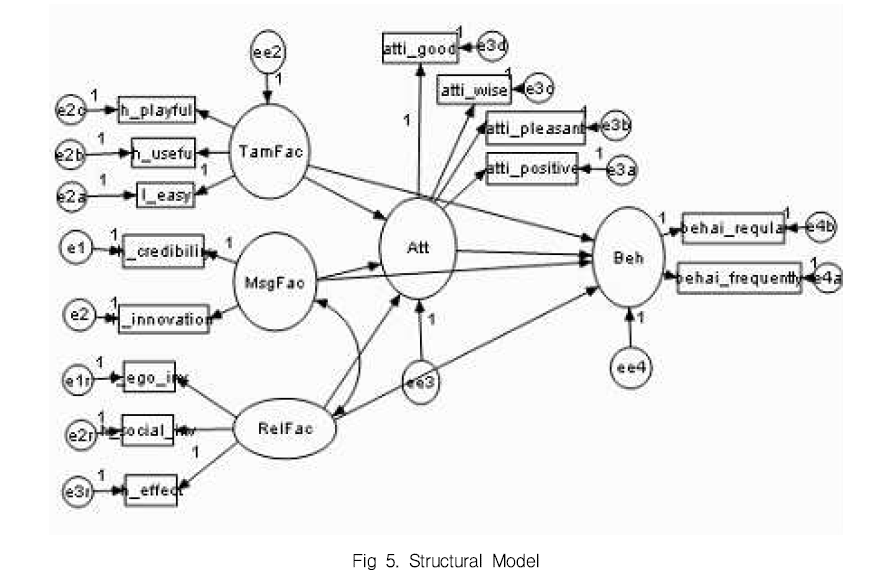
[PNG image (217.41 KB)]
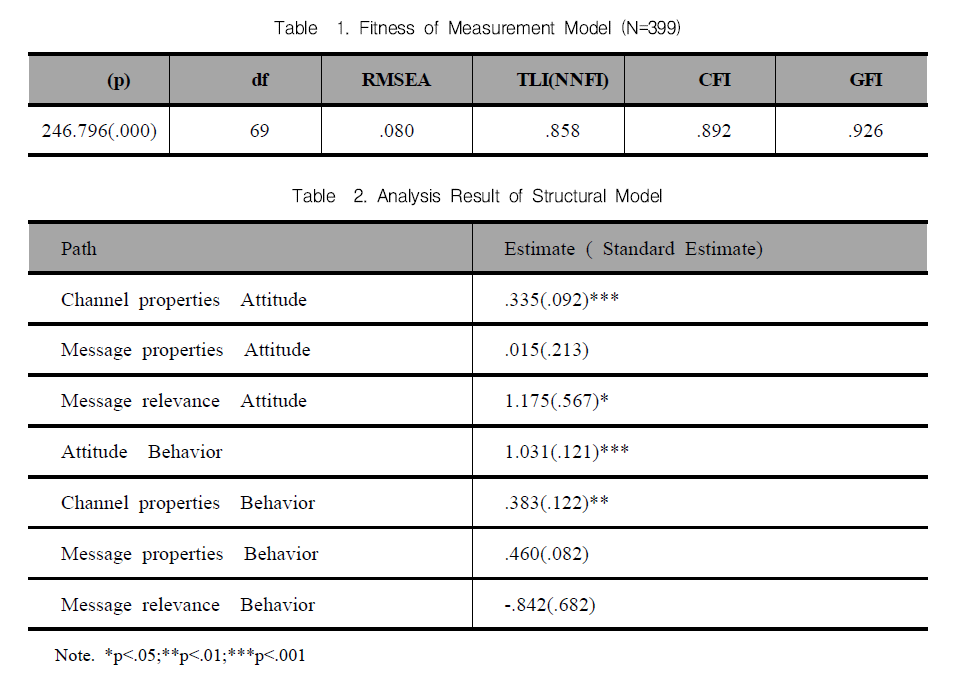
[PNG image (57.06 KB)]
First,
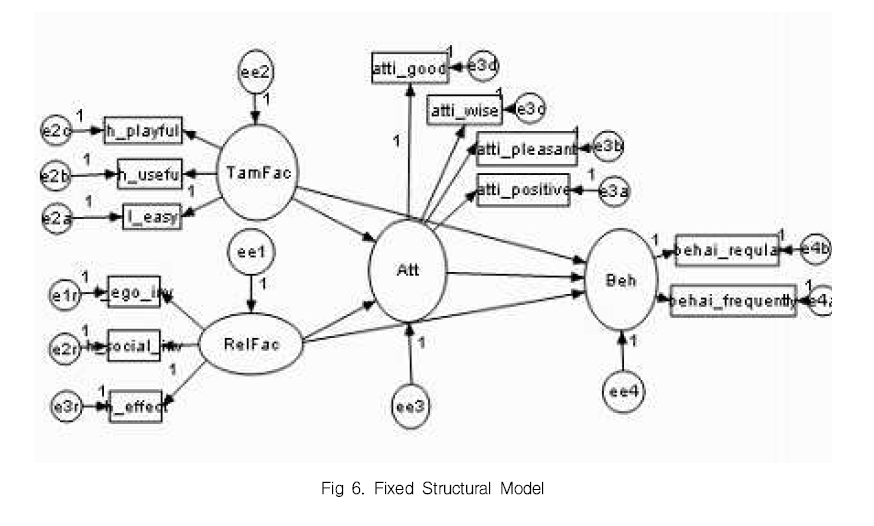
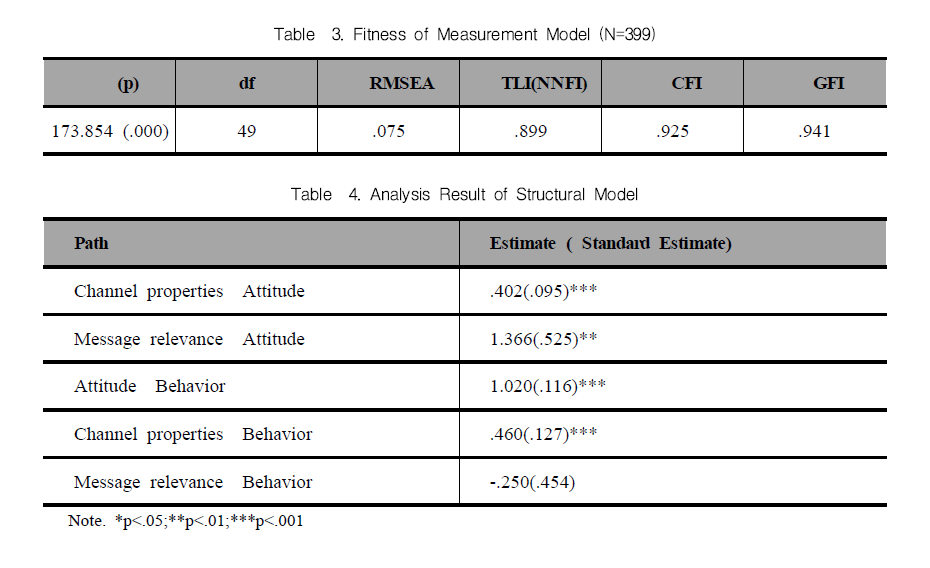
- Channel properties (EOU, Usefulness, Playfulness) are influential for the attitudes toward message diffusion.
- Message relevance (ego and others involvement) also influence the attitudes toward message diffusion.
- Only channel properties affect behavior of message diffusion (creating and responding messages).
- Playfulness (amusement of using the channel) is the most compelling reason of using microblog systems.
- Playfulness (amusement of using the channel) is the most compelling reason of using microblog systems.
- Other channel characteristics (EOU, Usefulness) are found to be mediating elemetns influencing playfulness.
Attitudes affect behavior

[PNG image (189.04 KB)]

[PNG image (45.82 KB)]
Microblog is becoming a message diffusing channel. However, this is happening at an amusement (personal perception of enjoyment) level. It does not carry social impacts, yet.
8. References ¶
- 김관규 (2009). 새로운 미디어 환경에서의 뉴스 전파에 관한 탐색적 연구. 언론과학연구, 9(2), 47-76.
- 양성관, & 양성운 (2003). 뉴스 미디어 신뢰도가 뉴스 수용자의 위기지각(risk perception)에 미치는 영향. 한국언론학보, 47(6), 279-305.
- 이경렬, 이철영, & 장성복 (2007). 인터넷 문맥광고(contextual ad)의 효과에 관한 연구. 한국방송학보, 21(4), 176-216.
- 이동후 (2009). 융합 미디어 환경, 트랜스리터러시, 그리고 디지털 주체의 양가성: 한국방송학회.
- 이재신 (2006). 기술사용에 대한 태도 변화에 영향을 미치는 요인들에 관한 종단적 연구. 한국언론학보, 50(6), 388-414.
- 이정환 (2009, 9월10일 10:56:00). 빛의 속도 트위터, 굼뜬 올드미디어. 미디어 오늘 from http://www.mediatoday.co.kr/news/articleView.html?idxno=82792
- 전종홍, 이. (2007). 특집 웹 2.0 : 모바일 웹 2.0 기술. 정보처리학회지, 14(4), 53-62.
- 최윤정 (2009). 온라인 커뮤니티 속 오피니언 리더 집단 검증. 한국언론학보, 53(4), 372-394.
- 현경미 (2008). 기대가치 이론 관점의 UCC 이용행태 연구. 한국언론학보, 52(5), 227-254.
- Ajzen, I. (1991). The theory of planned behavior. Organizational Behavior and Human Decision Processes, 50(2), 179-211.
- Davis, F. D. (1989). Perceived Usefulness, Perceived Ease of Use, and User Acceptance of Information Technology. MIS Quarterly, 13(3), 319-340.
- Herbjørn Nysveen, P. E. P., Helge Thorbjørnsen (2005). Intentions to use mobile services: Antecedents and cross-service comparisons. Journal of the Academy of Marketing Science, 33(3), 330-346.
- Hossain, L., & de Silva, A. (2009). Exploring user acceptance of technology using social networks. The Journal of High Technology Management Research, 20(1), 1-18.
- Moon, J.-W., & Kim, Y.-G. (2001). Extending the TAM for a World-Wide-Web context. Information & Management, 38(4), 217-230.
- Rogers, E. M. (2005). 개혁의 확산 (강. 김영석, 박현구, Trans.). Seoul: 커뮤니케이션북스.
- Scott, J. (2000). Social network analysis: A handbook. London: Sage Publications.
- Sweeney, J. C., & Soutar, G. N. (2001). Consumer perceived value: The development of a multiple item scale. Journal of Retailing, 77(2), 203-220.
- Wikipedia (2009). Microblog Retrieved 09/30, 2009, from http://en.wikipedia.org/wiki/Microblog
9. Social Network Analysis ¶
- Simple project (e.g.)
- Students taking classes
MATRIX SC
->dsp sc
1 2 3 4 5 6 7
P O A C M P A
- - - - - - -
1 A 1 1 1
2 B 1 1 1
3 C 1 1 1
4 D 1 1 1
5 E 1 1 1 1
6 F 1 1 1
7 G 1 1 1 1
8 H 1 1 1 1
9 I 1 1 1 1 1
10 J 1 1 1 1
11 K 1 1 1 1
Courses { PR OrgCom Adv CMC MedInd PopCul AmFilm }
Students { A B C D E F G H I J K }
->dsp cs
1 1
1 2 3 4 5 6 7 8 9 0 1
A B C D E F G H I J K
- - - - - - - - - - -
1 PR 1 1 1 1 1 1
2 OrgCom 1 1 1 1
3 Adv 1 1 1 1 1
4 CMC 1 1 1 1 1 1 1 1 1
5 MedInd 1 1 1 1 1 1
6 PopCul 1 1 1 1 1
7 AmFilm 1 1 1 1 1
MATRIX STU = sc * cs
->dsp s
1 1
1 2 3 4 5 6 7 8 9 0 1
A B C D E F G H I J K
- - - - - - - - - - -
1 A 3 1 1 3 3 2 1 1 2 1 1
2 B 1 3 1 1 1 1 2 3 2 3 2
3 C 1 1 3 1 2 2 2 1 2 1 1
4 D 3 1 1 3 3 2 1 1 2 1 1
5 E 3 1 2 3 4 3 1 1 3 1 2
6 F 2 1 2 2 3 3 1 1 2 1 2
7 G 1 2 2 1 1 1 4 3 2 3 2
8 H 1 3 1 1 1 1 3 4 3 4 3
9 I 2 2 2 2 3 2 2 3 5 3 3
10 J 1 3 1 1 1 1 3 4 3 4 3
11 K 1 2 1 1 2 2 2 3 3 3 4
MATRIX COU = cs * sc
->dsp c
1 2 3 4 5 6 7
P O A C M P A
- - - - - - -
1 PR 6 3 3 4 2 1 1
2 OrgCom 3 4 2 4 1 0 1
3 Adv 3 2 5 4 2 1 2
4 CMC 4 4 4 9 4 4 4
5 MedInd 2 1 2 4 6 4 4
6 PopCul 1 0 1 4 4 5 4
7 AmFilm 1 1 2 4 4 4 5
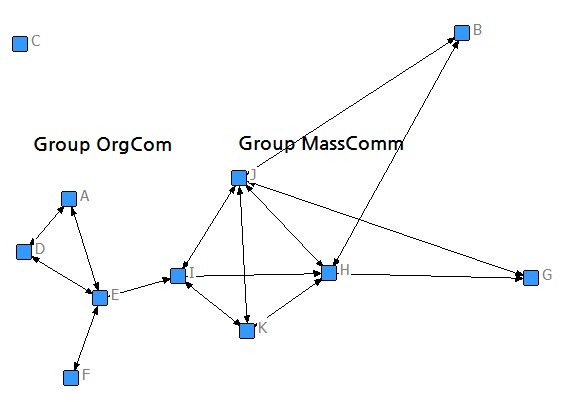
line=more than 2 [JPG image (31.34 KB)]
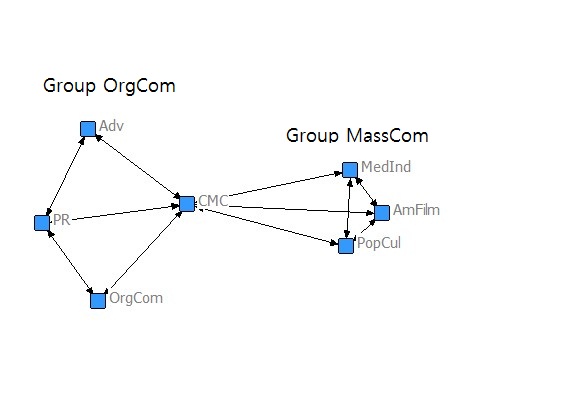
line=more than 2 [JPG image (24.29 KB)]













